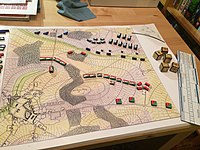Computer wargame

| Part of a series on |
| Wargames |
|---|
 |
A computer wargame is a
History
Computer wargames derived from tabletop
Wargame designer
SSI and Strategic Studies Group (SSG) were computer game companies that continued the genre by specializing in games that borrowed from board and miniature wargames. The companies enjoyed a certain popularity throughout much of the 1980s and into the 1990s. TalonSoft started in 1995 with a similar focus, until purchased and later closed down by Take-Two Interactive in 2002.
Game design
Computer wargames primarily focus on simulated battles. Because it is difficult to provide an intelligent way to delegate tasks to a subordinate, war games typically keep the number of units down to hundreds rather than hundreds of thousands.[11] The amount of realism varies between games as game designers balance an accurate simulation with playability.
Units are usually scaled to be disproportionately large compared to the landscape, in order to promote effective gameplay. These games usually use a much faster time line than reality, and thus wargames often do not model night time or sleep periods, though some games apply them, they can be time-consuming.[11]
Comparison with board wargames
Notable computer wargames
This article needs additional citations for verification. (December 2018) |
- 1980) - generally credited as the first "serious" computer war-game.
- Atari 8-bit family. Introduced scrolling maps, pondering AI, morale, supply considerations and many other advanced features that were common in later games. Chris Crawford'sfirst major success.
- Gary Grigsby's Pacific War (1993)
- 1994) - recognizably a traditional wargame next to Close Combat. It spawned several sequels, some of which explored different subject matter.
- Battleground series (TalonSoft, 1995–1999)
- 1995) - a tactical wargame on the same scale as Squad Leader, which led to two sequels, and then a series of titles by Camo Workshop/Shrapnel Games and Matrix Games, for free release.
- 1996) - not the first wargame to break out from hexes, and still presented in a 2-dimensional format, Close Combat addressed factors such as individual morale and reluctance to carry out orders. The original title led to five successful sequels for the general public, as well as being developed into a training tool for military use only. Close Combat stemmed from an early attempt to translate the Squad Leader boardgame to the computer.
- The Operational Art of War Vol. 1: 1939–1955 - (TalonSoft, 1998)
- 2000)
- Decisive Battles of WWII: Korsun Pocket - (Strategic Studies Group, 2003)
- TacOps – (Major I.L. Holdridge, 2003 for v4) – commercial version of “TacOpsCav 4”, an officially issued standard training device of the US Army. It is a simulation of contemporary and near-future tactical, ground, combat between the modern armed forces of the world.
- Wargame: Red Dragon – (Eugen Systems, 2014) – a 3D regiment or brigade scale simulation set as a "Cold War Gone Hot" themed game in both multiplayer and singleplayer environments. Players construct customized armies through use of a deck system comprising land vehicles, infantry, and helicopters from several NATO and Warsaw Pact nations and manage logistics such as fuel and ammunition while on the battlefield. There is no cohesive campaign, the game instead taking place in several hypothetical conflicts.
- Hegemony - (Longbow Games) - a series of historical wargames set in antiquity, with real-time strategy and real time battles on one seamless map, notable for its elegant supply system.
- Ultimate General - a series of strategy wargames based on the American Civil War
- Total War – a wargame set in different time periods, with a turn based map, and a real time battle component, featured on the television series Time Commanders
- Hearts of Iron – (Paradox Interactive) − a grand strategy wargame series that is focused on World War 2. Player may act as any reasonably sized nation at the time, influencing international politics, economic and military development, and can control battlefields on both strategic and operational levels using combined arms. Frequently used to entertain and simulate alternative history scenarios as well as recreate historical events.
- DEFCON (video game) - (Introversion Software)
- World Warfare & Economics – (Okron Studio)
See also
- Chronology of grand strategy video games
References
- ^ Proctor, Bob (March 1988). "Titans of the Computer Gaming World / SSI". Computer Gaming World. p. 36.
- ^ "This is why we play war games". Plarium. Retrieved 2018-03-29.
- ^ a b Ritchie, Craig (October 2007). "Developer Lookback; Strategic Simulations Inc (Part 1 of 2)". Retro Gamer (42): 34–39.
- ^ Staff (May–June 1982). "Hobby and Industry News". Computer Gaming World. Vol. 3, no. 3. p. 4.
- ^ Staff (February 1983). "The Player's Guide to Computer Games; The World Marches to War!". Electronic Games. 1 (12): 47–49.
- ISBN 978-0-429-77139-2.
- ^ Dunne, Alex (19 June 1997). "Interview with Gary Grigsby, Developer of SSI's Steel Panthers".
- ^ Mayer, Robert (January 10, 2001). "Uncommon Valor: Campaign for the South Pacific First Look". Computer Games Magazine. Archived from the original on April 19, 2005.
- Game Developer Magazine. Archived from the originalon January 21, 1998.
- ^ Ritchie, Craig (November 2007). "Developer Lookback; Strategic Simulations Inc (Part 2 of 2)". Retro Gamer (43): 82–87.
- ^ a b Rollings, Andrew; Ernest Adams (2006). Fundamentals of Game Design. Prentice Hall.
